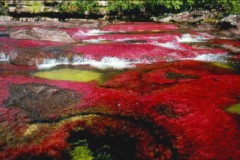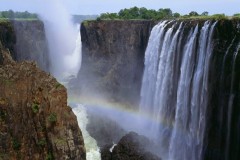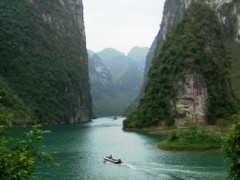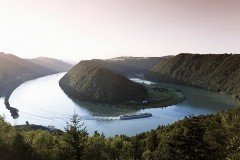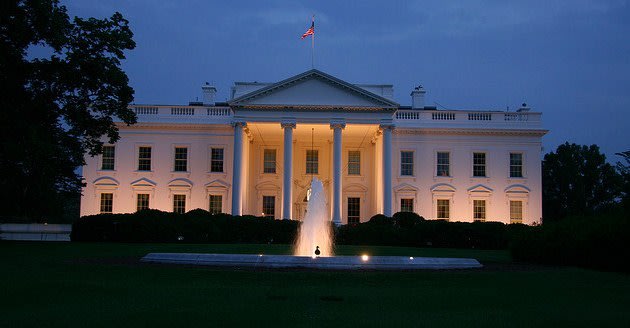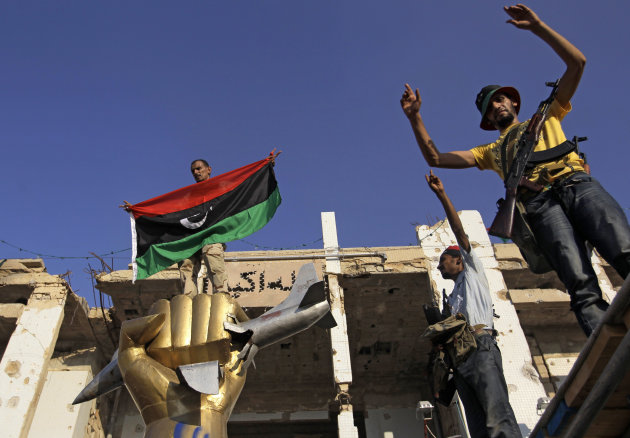
TRIPOLI, Libya (AP) — Hundreds of Libyan rebels stormed Moammar Gadhafi's compound Tuesday, charging wildly through the symbolic heart of the crumbling regime as they killed loyalist troops, looted armories and knocked the head off a statue of the besieged dictator. But they found no sign of the man himself.
The storming of Bab al-Aziziya, long the nexus of Gadhafi's power, marked the effective collapse of his 42-year-old regime. But with Gadhafi and his powerful sons still unaccounted for — and gunbattles flaring across the nervous city — the fighters cannot declare victory.
Hours after the battle erupted, a pro-Gadhafi TV channel quoted the Libyan leader as saying he retreated from his Tripoli compound in a "tactical move" after 64 NATO airstrikes turned it to rubble. Al-Rai TV said Wednesday it would air the comments in full and reported an excerpt in which Gadhafi vowed his forces would resist "the aggression with all strength" until either victory or death.
His government's chief spokesman also managed to get word out in a phone interview with the same station, promising "we will be back to take Tripoli back."
The rebel force entered the compound after fighting for five hours with Gadhafi loyalists outside, using mortars, heavy machine guns and anti-aircraft guns. They killed some of those who defended the compound and hauled off thousands of rifles, crates of weapons and trucks with guns mounted on the back in a frenzy of looting.
"We're looking for Gadhafi now. We have to find him now," said Sohaib Nefati, a rebel sitting against a wall with a Kalashnikov rifle.
Abdel-Aziz Shafiya, a 19-year-old rebel dressed in camouflage with a rocket-propelled grenade slung over one shoulder and a Kalashnikov over the other, said the rebels believed Gadhafi was inside the compound but hiding underground.
"Wasn't he the one who called us rats? Now he is the rat underground," he said.
Shafiya said he felt "an explosion of joy" to be standing inside Gadhafi's stronghold in the capital after a lightning-quick rebel advance. He had left the rebel-held western city of Misrata just two days earlier.
"I lost friends and relatives and now I can walk into Gadhafi's house," Shafiya said, choking up with emotion. "Many of my friends have died and now all of that meant something."
Tripoli's new rebel military chief, Abdel-Hakim Belhaj, said at nightfall that a small area of the vast compound was still under the control of regime fighters and heavy shooting was heard across Tripoli toward midnight.
The atmosphere in the compound was a mix of joyful celebration and tension. The air was thick with smoke from the battles, and the boom of mortars and the crackle of gunfire was constant. Rebels chanted "Allahu akbar" or "God is great" and on loudspeakers they cried: "Al-Hamdullilah," or "Thank God."
As the fighters stormed in, they captured a guard at the gates and threw him to the ground, slamming rifle butts into his back. A hostile crowd gathered around, punching and kicking him until one rebel stepped in, stood over him and kept the crowd at bay. Inside the walls, a few bodies of Gadhafi fighters — one with a gaping head wound from a gunshot — were sprawled on the ground.
Several young men wrenched the head from a statue of Gadhafi and kicked it around. One lifted it above his head while his jubilant comrades danced and yelled around him. Fighters with long beards hugged each other and flashed the "V'' for victory sign. Others carried injured rebels to ambulances.
A fighter climbed atop the iconic statue of a huge golden fist clenching a model of an American warplane and shot his machine gun in the air in celebration. The statue stands outside a building that was once Gadhafi's home, preserved with the pockmarks of an American bombing in 1986 as a symbol of his defiance.
Gadhafi delivered many fiery speeches from the balcony of that house, railing against the West. It was there that he appeared on television six months ago, at the beginning of the uprising, mocking his opponents and saying his supporters would "purify Libya inch by inch, house by house, alley by alley."
Bab al-Aziziya has since been pummeled many times over by NATO bombings in the air campaign against the regime that began in March.
In Wednesday's TV interviews, Gadhafi and government spokesman Ibrahim called the withdrawal from the compound strategic.
"Bab al-Azaziya is nothing but slabs of concrete after 64 NATO airstrikes," Ibrahim said in a two-hour phone interview with Al-Rai TV. "Our departure from there is a strategic move and we will be back to take Tripoli back."
He claimed Gadhafi's forces still controlled 80 percent of the capital, which he said was a "death trap" and "ticking time bomb" for the rebels.
Thousands of rebels converged on the compound after it was breached, snatching ammunition and arms from depots inside. They found brand-new rifles still in their paper wrappings.
Scuffles broke out among rebels pushing and shoving to get inside two white buildings where the rifles, machine guns and handguns are stored. They came out drenched in sweat from the struggles.
One fighter gleefully blasted rocket-propelled grenades over the compound's eastern wall, with little idea about what was happening on the other side.
Ali Sameer, a Tripoli resident, stood with three brand-new rifles resting on his legs.
"They are for my friends. I don't even know how to fight," he said.
The rebels carted out boxes of the weapons and ammunition, and some drove off with trucks mounted with anti-aircraft guns on the back.
One drove out with a golf cart. Another walked out with a fan. Others were busy ripping down posters of Gadhafi.
Near Gadhafi's old home with the statue outside, the body of a dead regime loyalist lay inside a round building with glass windows shot out. The body was partly covered by a blanket, the head sticking out with a gaping gunshot wound.
A large tent nearby was on fire.
Gadhafi has a famous penchant for Bedouin-style tents, meant to symbolize his roots as a simple desert dweller. He received guests in the tents inside Bab al-Aziziya.
The storming of the compound was a new high for the rebels in what has been an emotional roller coaster since they moved into Tripoli on Sunday night. It began with euphoria and claims that they had taken over most of the city with little resistance. The first night they partied in Green Square, a major symbol of the regime where Gadhafi supporters had held almost nightly rallies throughout the uprising. And it seemed Gadhafi rule was teetering on the brink of collapse.
In the early morning hours of Tuesday, there was a shocking setback. The rebels had claimed that they arrested Gadhafi's son and heir apparent, Seif al-Islam. It was confirmed by the International Criminal Court in the Netherlands, which has charged him and his father with crimes against humanity.
But inexplicably, Seif al-Islam showed up at the hotel where foreign journalists are staying under the close watch of regime minders in early morning hours of Tuesday. He giddily took reporters on an eerie drive in the middle of the night to see hundreds of pro-regime gunmen around Bab al-Aziziya and at least a hundred more lined up outside, where guns were being handed out to volunteers.
The rebels waited hours to explain, saying word of his capture had come from secondhand reports from some rebels that were never confirmed and had been leaked to journalists. But in an indication that the announcement of his arrest might have been a ruse calculated to demoralize the regime, Mahmoud Jibril, head of the rebels' acting Cabinet, said the reports had some political and military benefits.
"About 30 officers and soldiers surrendered when they heard the news, which helped us take over Bab al-Aziziya swiftly," he said. "And 11 countries recognized the (rebels') National Transitional Council after receiving news of his arrest."
By Tuesday morning, it looked like the capital might descend into bloody urban warfare. There was sporadic gunfire in many parts. The rebels were in control of parts of the city, though it was not clear how extensive their control really was. Then the fighting took focus around Gadhafi's compound.
However, rebels were trying to establish civilian control in the chaotic city, even while fire fights continued.
In a deserted five-star hotel on the city's beachfront, a group of rebel leaders who had operated underground for the past six months announced that they had formed a 24-member city council and would now be in charge.
Deputy council chief Usama el-Abed el-Abed called on city workers to return their jobs so life could begin to return to normal. However, the founding members had not invited guests, saying the city was still too dangerous for large gatherings.
Gadhafi, meanwhile, has not been heard from since Sunday, when rebels entered Tripoli and he delivered a series of angry and defiant audio messages that were apparently phoned in to state television.
Kirsan Ilyumzhinov, the Russian head of the World Chess Federation who has known Gadhafi for years, said he spoke Tuesday by telephone with Gadhafi, who told him he was "alive and well and still in Tripoli." The report could not be independently confirmed.
In other parts of the capital, the rebels said they were also in control of state television. They raised their tricolor flag on the top of the building. Rebels claimed they also control the airport.
In Tripoli's Green Square, hundreds of rebels celebrated the storming of Bab al-Aziziya, dancing and clapping and waving the red, green and black rebel flag and firing celebratory gunfire in the air.
Libya's former deputy ambassador to the U.N. said he expected the entire country would be in rebel hands within 72 hours. Ambassador Ibrahim Dabbashi, who with other diplomats has continued to work at the Libyan mission since disavowing Gadhafi in February, said Tuesday he expects Libya will be "totally liberated."
In the de facto rebel capital of Benghazi, hundreds of miles east of Tripoli, the news of the Bab al-Aziziya storming was greeted with celebratory gunfire and firecrackers. Men drove around waving rebel flags.
Wael Abu Khris, a shipping agent turned rebel fighter from Tripoli, was walking around Gadhafi's compound after the battle, carrying his Kalashnikov.
"I feel great satisfaction. We are at last free of this dictator," he said. "Libya is free at last. No more Gadhafi!"









